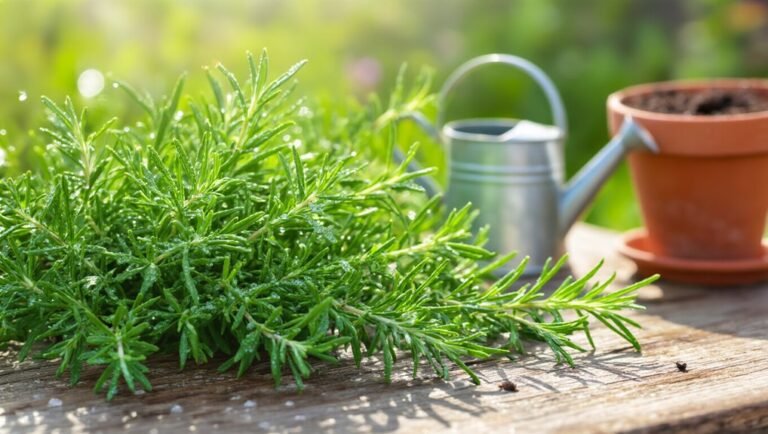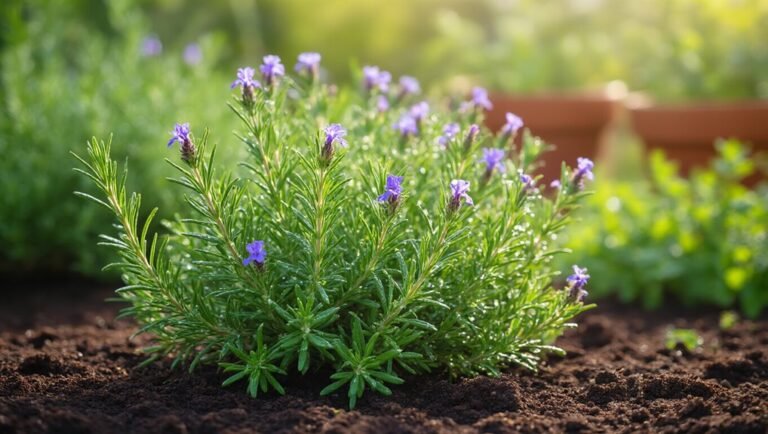To grow rosemary at home, start by selecting a 12-inch pot with drainage holes. Use a quality potting mix, adding sand or perlite for drainage. Place your plant in full sun for 6-8 hours daily and keep temperatures between 65°F and 75°F. Water only when the top inch of soil is dry, and fertilize every 4-6 weeks. Don’t forget to prune in spring for healthier growth. Learn more tips to ensure your rosemary thrives!
Key Takeaways
- Choose a pot with at least 12 inches in diameter and drainage holes for healthy root growth.
- Use a high-quality potting mix with added coarse sand or perlite for improved drainage.
- Place rosemary in full sun for 6-8 hours daily and maintain temperatures between 65°F and 75°F.
- Water thoroughly but infrequently, allowing the top inch of soil to dry out between waterings.
- Prune in spring by cutting back one-third of the plant to encourage growth and prevent stress.
Selecting the Right Pot for Your Rosemary
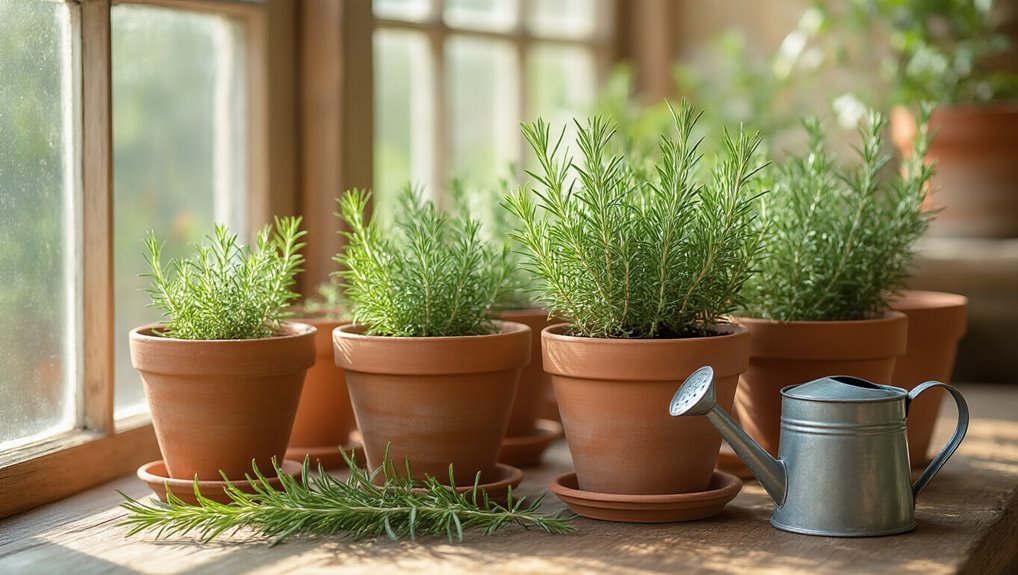
When growing rosemary at home, selecting the right pot is crucial for its health and growth. Choose a pot that’s at least 12 inches in diameter, allowing enough space for the roots to spread. Opt for a container with drainage holes to prevent waterlogging, as rosemary prefers well-drained soil. Consider materials like terracotta or ceramic, which allow for better airflow and moisture regulation. When choosing a pot, it’s worth exploring beautiful plant pots to not only support healthy rosemary but also elevate your home’s style. If you’re using plastic, make sure it’s lightweight and durable, but be cautious about overwatering. You’ll want to repot your rosemary every couple of years to refresh the soil and encourage robust growth. For gardeners looking to expand their herb collection, raised garden beds offer an excellent way to organize and elevate your gardening experience.
Choosing the Best Soil Mix
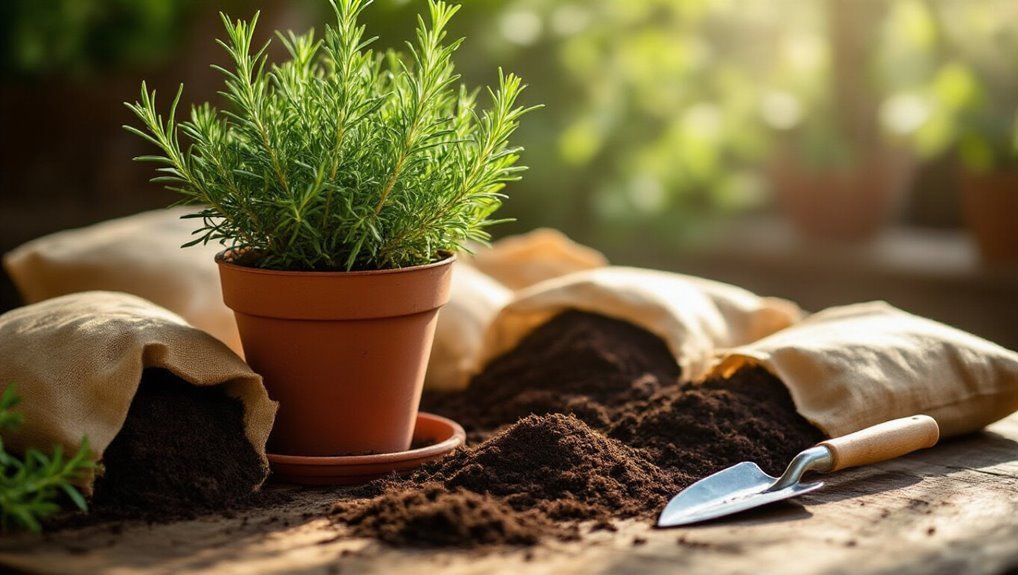
To ensure your rosemary thrives, choosing the best soil mix is essential. Rosemary prefers well-draining soil that mimics its Mediterranean origins. Here’s what you should look for in your soil mix:
- Potting Soil: Use a high-quality potting mix as a base to provide essential nutrients.
- Sand or Perlite: Add a mix of coarse sand or perlite to enhance drainage and prevent root rot. For even better results, consider using a soil sifter or screen to remove large debris, ensuring your soil mix is fine-textured and consistent.
- Coconut Coir: Incorporate coconut coir for moisture retention without waterlogging the roots.
- Organic Matter: Consider mixing in a small amount of organic compost for added nutrients.
Selecting the best garden soil is a key factor in ensuring your plants grow healthy and strong.
Ideal Growing Conditions for Rosemary
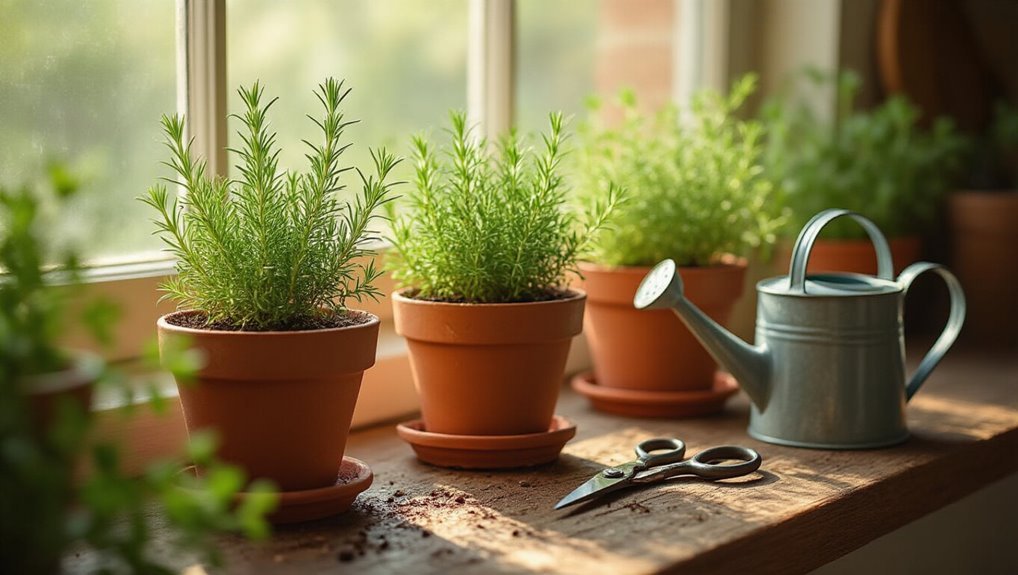
Rosemary flourishes in specific conditions that mimic its native Mediterranean habitat. To create an ideal environment, place your rosemary in a spot with full sun for at least six to eight hours a day.
It loves warmth, so aim for temperatures between 65°F and 75°F during the day and slightly cooler at night. For maintaining healthy growth, consider using pruning shears to trim your rosemary and promote bushier, more productive plants. Ensure your growing area has good air circulation, as rosemary thrives in dry conditions and can suffer from mold in overly humid areas.
Use a well-draining pot or garden bed to prevent waterlogged roots. If you’re growing indoors, consider a south-facing window for optimal light.
If you are interested in growing other plants with specific needs, you might want to explore essential supplies for thriving orchids, which can provide useful tips and products for maintaining healthy plants in your home.
With these conditions met, your rosemary will grow strong, aromatic, and ready for use in your culinary creations!
Watering and Fertilizing Your Plant
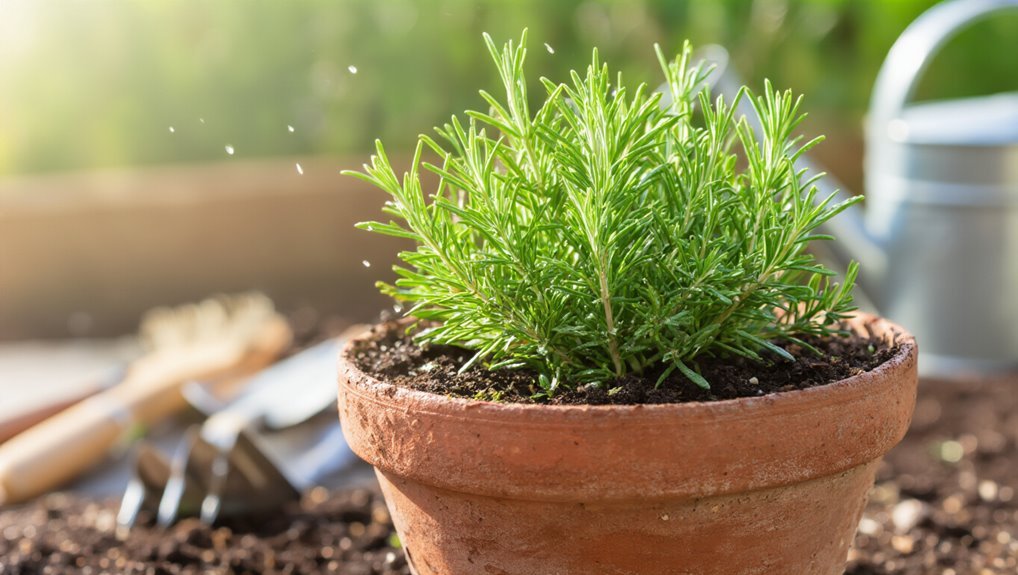
While it’s tempting to overwater your rosemary, striking the right balance is crucial for its health. Rosemary prefers slightly dry soil, so check the moisture levels before watering. For best results, it’s helpful to use quality plant food to ensure your rosemary receives essential nutrients throughout its growth.
Aim to water it thoroughly but infrequently, allowing the top inch of soil to dry out between sessions.
When it comes to fertilizing, follow these guidelines:
- Use a balanced, water-soluble fertilizer every 4-6 weeks during the growing season.
- Dilute the fertilizer to half-strength to avoid overwhelming the plant.
- Stop fertilizing in late summer as rosemary enters dormancy.
- If your rosemary is in poor soil, consider repotting it with fresh, well-draining potting mix.
For an easy and effective way to nourish your rosemary, consider using Plant Fertilizer Tablets specifically designed to boost your garden’s growth.
Pruning and Harvesting Tips
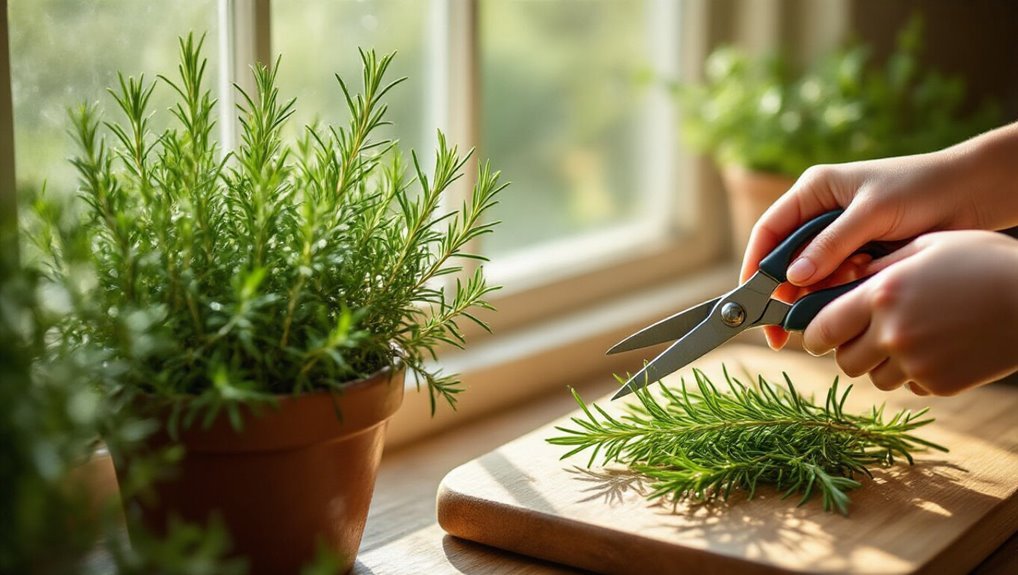
After ensuring your rosemary is well-watered and properly fertilized, it’s time to focus on pruning and harvesting.
Start pruning in spring, cutting back about one-third of the plant to encourage bushiness and new growth. Use sharp, clean shears to avoid damaging the stems.
Harvest leaves whenever you need them, but aim for the morning when the essential oils are at their peak. Snip off the top few inches of stems, leaving enough foliage for continued growth. Growing rosemary as part of an indoor herb garden allows for fresh herbs year-round, right in your kitchen.
Avoid over-harvesting; taking too much can stress the plant. If you notice flowers, prune them off to maintain flavor.
Regular pruning not only promotes healthy growth but also enhances the aroma and taste of your rosemary for culinary uses.
For an easy way to get started, consider using Herb Garden Kits with Seeds and Pots designed specifically for growing herbs like rosemary at home.
Common Pests and Problems to Watch For
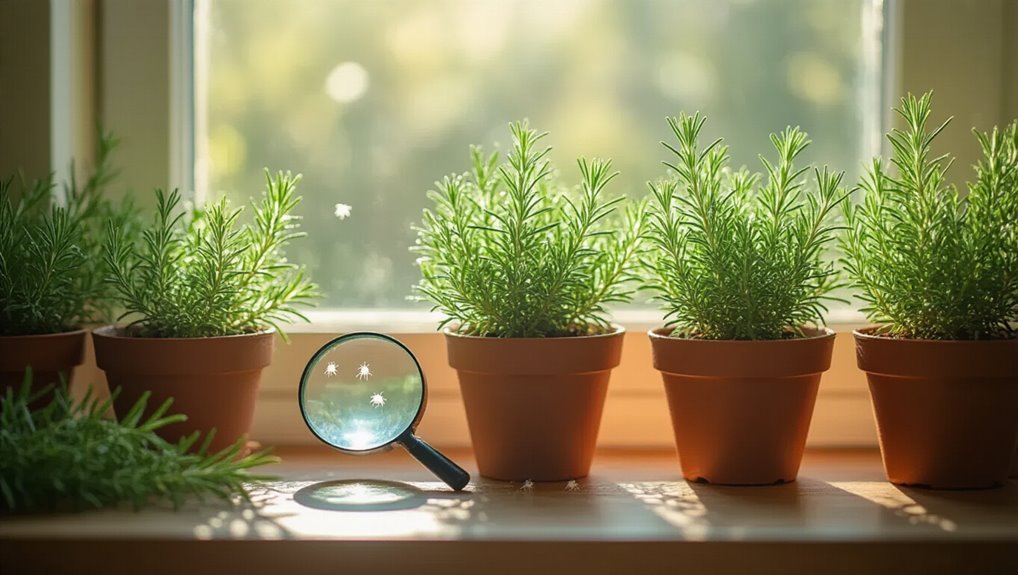
How can you keep your rosemary thriving and free from common pests? First, stay vigilant about potential threats that can harm your plant.
Here are some common pests and problems to watch for:
- Spider Mites: These tiny pests create webbing and cause leaves to yellow. Increase humidity to deter them.
- Aphids: These sap-sucking insects can stunt growth. Spray them off with water or use insecticidal soap.
- Whiteflies: Often found on the underside of leaves, they can cause leaf drop. Use yellow sticky traps for detection. For better results in managing whiteflies and other pests, consider using garden pest traps to effectively reduce their numbers.
- Fungal Diseases: Look for mold or mildew. Ensure good air circulation and avoid overhead watering.
If you notice an infestation, consider using effective solutions for pest control to protect your rosemary and keep your garden healthy.
Frequently Asked Questions
Can I Grow Rosemary Indoors Year-Round?
Did you know that rosemary can thrive indoors with proper care? Yes, you can grow rosemary year-round indoors. Just ensure it gets enough sunlight, well-draining soil, and regular watering, and you’ll enjoy fresh herbs anytime!
How Long Does It Take for Rosemary to Grow?
It usually takes about three to six weeks for rosemary seeds to germinate. Once they sprout, you’ll wait another few months for them to grow strong enough for harvesting. Patience is key during this process!
Is Rosemary Safe for Pets?
Yes, rosemary is generally safe for pets, especially dogs and cats, in small amounts. However, if your pet consumes large quantities, it might cause mild gastrointestinal upset. Always monitor your pet’s reaction to new foods.
Can I Propagate Rosemary From Cuttings?
Imagine snipping a fresh rosemary sprig, its fragrant aroma wafting through the air. Yes, you can propagate rosemary from cuttings! Just place them in water or soil, and watch your new plants thrive.
What Companion Plants Work Well With Rosemary?
When you’re choosing companion plants for rosemary, consider planting sage, thyme, or lavender nearby. They thrive in similar conditions and can help deter pests, promoting a healthier garden environment for your herbs to flourish.
Conclusion
Growing rosemary at home isn’t just about nurturing a plant; it’s like cultivating a friendship. Just as a good friend needs sunlight, laughter, and care, your rosemary thrives in the right pot, soil, and conditions. Remember, every time you prune it or sprinkle its fragrant leaves into a dish, you’re not just harvesting; you’re sharing a piece of your garden with those you love. So, roll up your sleeves and let your rosemary flourish—it’s a bond worth growing!
